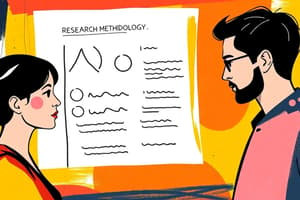Podcast
Questions and Answers
Approximately 55 new trials are published every week.
Approximately 55 new trials are published every week.
False (B)
To keep up to date with RCTs alone, a GP would have to read more than one study report every hour.
To keep up to date with RCTs alone, a GP would have to read more than one study report every hour.
False (B)
In 2005, about 1800 papers were also indexed daily on MEDLINE.
In 2005, about 1800 papers were also indexed daily on MEDLINE.
True (A)
Most medical practitioners, particularly GPs, are overloaded with too little information.
Most medical practitioners, particularly GPs, are overloaded with too little information.
The total number of RCTs published has decreased exponentially since the 1940s.
The total number of RCTs published has decreased exponentially since the 1940s.
A total of 10,000 trials are published each year.
A total of 10,000 trials are published each year.
Unsolicited information received through the mail alone can amount to kilograms per year.
Unsolicited information received through the mail alone can amount to kilograms per year.
There is too little information available for medical practitioners.
There is too little information available for medical practitioners.
More than 300,000 trials are published in total.
More than 300,000 trials are published in total.
Doctors need to be linked to the medical research literature to obtain outdated information.
Doctors need to be linked to the medical research literature to obtain outdated information.
Flashcards are hidden until you start studying
Study Notes
The Importance of Evidence-Based Practice
Most published information is irrelevant, and methods are not good, making it difficult to find high-quality evidence, similar to finding rare pearls in a hose of dirty water. This highlights the importance of critically evaluating the vast amount of information available, and being mindful of the sources and methods used to generate the evidence.
In addition, the exponential growth of medical literature makes it increasingly challenging for healthcare professionals to stay updated on the latest research and best practices. This emphasizes the need for a systematic approach to identifying, evaluating, and implementing evidence-based practices.
Information Gathering
There are two ways to get information:
'Just in case': ad hoc information from the vast amount of information that crosses our desk or arrives in our inbox daily (‘push’). This approach can be overwhelming and inefficient, as it involves sifting through a large amount of information, much of which may be irrelevant or outdated.
'Just in time': targeted information, seeking out information in response to a specific question (‘pull’). This approach is more focused and efficient, as it involves actively seeking out information to address a specific clinical question or problem.
Good sources of information include Clinical Evidence (http://www.clinicalevidence.com), which provides comprehensive and up-to-date summaries of the best available evidence on various medical topics.
In addition to Clinical Evidence, other reliable sources of information include the Cochrane Collaboration, the National Institute for Health and Clinical Excellence (NICE), and the American College of Physicians (ACP) Journal Club.
The Case for Evidence-Based Practice
EBP enhances healthcare quality, improves patient outcomes, reduces costs, and empowers clinicians, known as the quadruple aim in healthcare. By adopting an evidence-based approach, healthcare professionals can ensure that their practices are informed by the best available evidence, leading to better patient outcomes and more efficient use of resources.
Despite the availability of scientific evidence, its implementation is still not the norm in many healthcare systems due to clinicians lacking competency in EBP and cultures steeped in tradition. This highlights the need for ongoing education and training in EBP, as well as a cultural shift towards an evidence-based approach to healthcare.
The benefits of EBP extend beyond healthcare quality and patient outcomes, as it also has economic and social implications. By reducing unnecessary tests and treatments, EBP can help reduce healthcare costs and improve resource allocation.
The Flecainide Story
The use of flecainide to treat heart attacks in the US in the 1980s is an example of the gap between research and clinical practice, and the reliance on evidence of a mechanism rather than an outcome. This case highlights the importance of critically evaluating the evidence, rather than relying on assumptions or mechanisms.
The researcher's mistake was not looking for additional information beyond the mechanism, which would have revealed that flecainide increased deaths. This underscores the importance of considering multiple sources of evidence and evaluating the strength of the evidence before making clinical decisions.
The flecainide story serves as a cautionary tale for healthcare professionals, highlighting the potential risks of relying on incomplete or inadequate evidence. It emphasizes the need for a systematic and multidisciplinary approach to evaluating evidence and making clinical decisions.
Keeping Up-to-Date with Medical Literature
In 2005, approximately 55 new trials were published every day, and a GP would have to read more than one study report every half hour, day and night to keep up-to-date with RCTs alone. This highlights the sheer volume of medical literature being published,
Studying That Suits You
Use AI to generate personalized quizzes and flashcards to suit your learning preferences.




